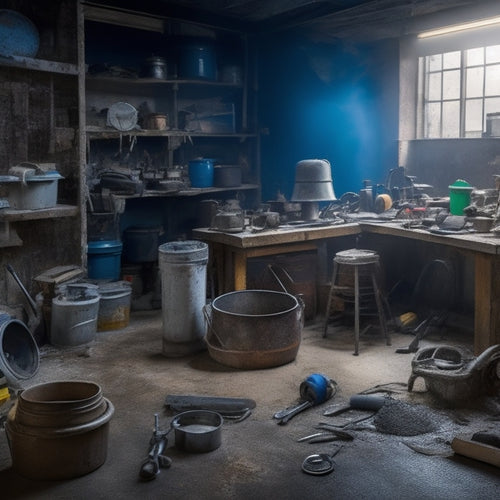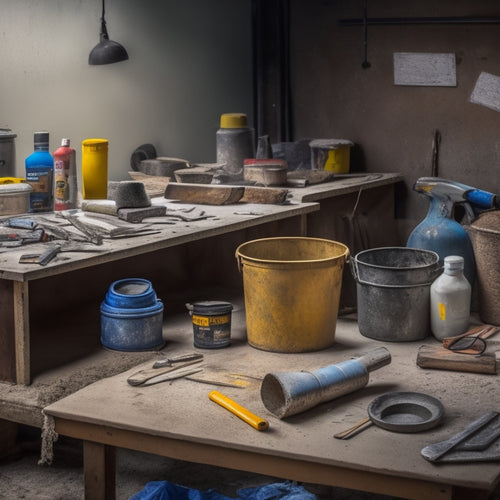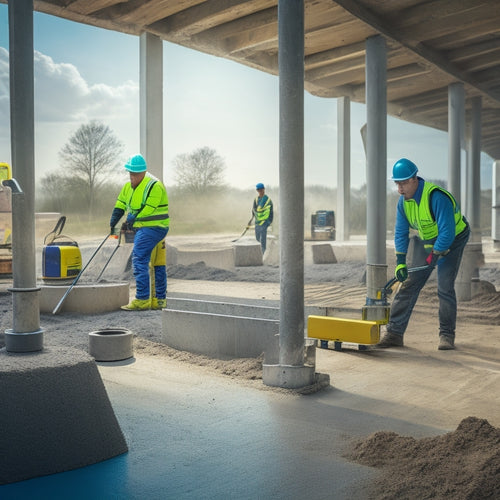
What Power Tools Do I Need for Concrete Repairs
Share
You'll need a combination of high-powered tools, including an angle grinder, rotary hammer, and concrete saw, to effectively remove damaged concrete, drill into concrete for anchoring, and make precise cuts during concrete repair projects. A dustless vacuum or HEPA-filter vacuum is also essential for containing dust. Additionally, specialized equipment like a concrete scarifier, epoxy injection gun, and core drills may be necessary depending on the scope of your project. With the right tools, you'll be well-equipped to tackle complex concrete repairs and achieve professional-looking results - and there's more to explore when it comes to selecting the perfect tools for your specific needs.
Key Takeaways
- A high-powered angle grinder is essential for removing damaged concrete and heavy-duty smoothing tasks.
- A rotary hammer drill with masonry bits is necessary for drilling into concrete for anchoring and other tasks.
- A concrete saw with a diamond blade is required for making precise cuts in concrete.
- A dustless or HEPA-filter vacuum is crucial for containing dust and debris during concrete repairs.
- Specialized tools like concrete scarifiers, epoxy injection guns, and core drills may be needed for specific repair tasks.
Top Power Tools for Concrete Block Home Repair
When it comes to repairing your concrete block home, having the right power tools can make all the difference in getting the job done efficiently and effectively.
You'll need tools that can withstand the rigors of concrete repair techniques, such as grinding, cutting, and drilling.
For concrete block repair, a high-powered angle grinder is vital. This tool allows you to quickly remove damaged or deteriorated concrete, making way for new material.
A rotary hammer, also known as a rotary drill, is another must-have. Its high-torque motor enables you to drill into concrete with ease, making it perfect for tasks like anchoring or installing reinforcement.
A concrete saw or circular saw with a diamond blade is also necessary for making precise cuts in concrete.
Additionally, a dustless vacuum or HEPA-filter vacuum is essential for containing dust and debris generated during the repair process.
With these power tools in your arsenal, you'll be well-equipped to tackle even the most challenging concrete block home repairs.
Essential Drilling Equipment for Anchors
Several essential drilling equipment pieces are necessary for successfully installing anchors in concrete block structures.
When it comes to anchor installation, having the right drill types can make all the difference.
You'll need the following equipment to get the job done efficiently:
-
Rotary hammer drill: This drill type is ideal for drilling into concrete, as it uses a hammering action to break up the material. Look for a model with a high torque output and adjustable speed settings.
-
Masonry bits: These specialized bits are designed specifically for drilling into concrete and are available in various diameters and lengths. They typically feature a tungsten carbide tip for added durability.
-
Anchor setting tool: This tool is used to set the anchor in place after drilling. It guarantees the anchor is properly seated and secure, providing a strong hold in the concrete.
With these essential drilling equipment pieces in your toolkit, you'll be well-equipped to tackle anchor installation projects with confidence.
Remember to always follow safety protocols and manufacturer instructions when working with power tools.
Concrete Cutting and Breaking Tools
You've got your anchors securely in place, now it's time to tackle the task of cutting and breaking concrete to make way for repairs or renovations. This phase requires the right tools to efficiently and safely remove damaged or unwanted concrete.
Concrete saws are a must-have for making precise cuts in concrete. They're available in various types, including walk-behind, handheld, and circular saws, each suited for specific tasks and concrete thicknesses.
Demolition hammers, also known as breakers, are essential for breaking up and removing large chunks of concrete. These powerful tools typically come with interchangeable bits and chisels, allowing you to adapt to different breaking tasks.
When choosing a demolition hammer, consider factors like impact energy, weight, and handle design to guarantee you get the right tool for your project.
Smoothing and Finishing Power Tools
The concrete surface is now clear of unwanted material, and it's time to focus on achieving a smooth, even finish.
You'll need the right power tools to apply various smoothing techniques and finishing methods to achieve a professional-looking result.
To achieve a smooth finish, you'll need:
-
Angle grinders: These powerful tools are ideal for heavy-duty smoothing and leveling. They can be fitted with various abrasives, such as diamond wheels or sanding discs, to tackle different types of concrete surfaces.
-
Polishers: These tools are designed for high-gloss finishing and can be used to apply a range of finishes, from matte to high-gloss. They're typically fitted with diamond polishing pads or resin-bonded discs.
-
Orbital sanders: These versatile tools are perfect for fine-tuning and polishing concrete surfaces. They can be fitted with various sanding pads, from coarse to fine, to achieve a smooth, even finish.
Specialized Equipment for Concrete Repair
With your concrete surface now smoothed and finished, it's time to tackle more complex repairs that require specialized equipment. For deeper cracks and structural damage, you'll need tools designed for advanced concrete resurfacing techniques.
A concrete scarifier, for instance, is perfect for removing old, damaged concrete and preparing the surface for new layers. When dealing with hairline cracks, epoxy injection methods come into play. An epoxy injection gun allows you to inject resin deep into the cracks, bonding the concrete and preventing further damage.
Other specialized tools include concrete saws for cutting through thick concrete, and core drills for creating precise holes for anchors or pipes. You may also need a concrete mixer for mixing and applying specialized repair compounds, and a pressure washer for cleaning the surface before applying new coatings.
Frequently Asked Questions
Can I Use Power Tools for Concrete Repairs in Wet Conditions?
When working in wet conditions, you'll need to prioritize safety precautions, selecting power tools with water-resistant features and proper grounding to prevent electrical shock, ensuring your tool selection is tailored to the specific demands of the job.
Do I Need Special Training to Operate Concrete Repair Power Tools?
You'll need to undergo specialized training to operate concrete repair power tools safely and effectively, focusing on safety precautions and proper tool selection to guarantee successful repairs and prevent accidents.
Are Power Tools for Concrete Repair Suitable for DIY Projects?
When tackling DIY concrete repair projects, you'll find that power tools can be suitable, but only if you take necessary safety precautions and make informed tool selections, ensuring you're equipped to handle the demands of the job effectively.
Can I Rent Power Tools for Concrete Repair Instead of Buying?
Like a master chef renting a commercial kitchen for a catering gig, you can rent power tools for concrete repair, comparing costs to buying; power tool rentals often make sense for one-time or infrequent projects, saving you money and storage space.
How Do I Maintain and Store Power Tools for Concrete Repair?
You guarantee tool longevity by following manufacturer guidelines, cleaning tools after each use, and storing them in dry, organized spaces with designated storage solutions, such as tool chests or pegboards, to maintain peak performance.
Conclusion
You've got the right tools for concrete repairs, now it's time to get to work. With the right equipment, you can tackle any concrete job. Did you know that the American Concrete Institute estimates that over 70% of concrete structures in the US are in need of repair? That's a staggering number, and it highlights the importance of having the right tools and skills to get the job done. With these power tools, you'll be well-equipped to tackle any concrete repair project that comes your way.
Related Posts
-

7 Tools to Fix Damaged Concrete Floors
You're about to tackle that damaged concrete floor, and the right tools are essential for a successful repair. Start ...
-

3 Best Tools to Buy for Concrete Repair Online
When buying tools for concrete repair online, you'll want to research multiple retailer options to find the best prod...
-

What Tools Ensure Precise Concrete Leveling Results
You need a range of specialized tools to achieve precise concrete leveling results. Laser leveling instruments provid...


